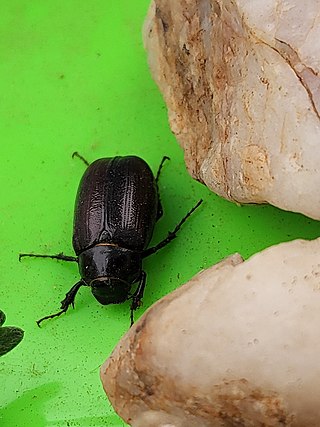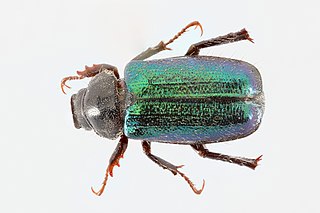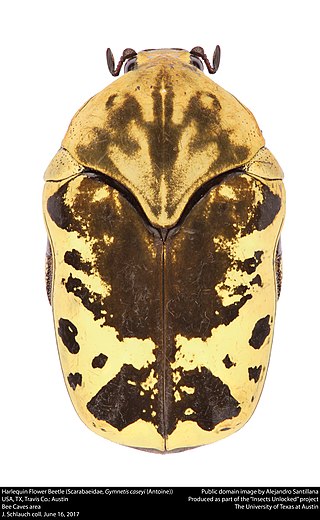
Ataenius is a genus of aphodiine dung beetles in the family Scarabaeidae. There are at least 290 described species in Ataenius.
Canthidium is a genus of dung beetles in the family Scarabaeidae. There are at least 170 described species in Canthidium.

Diplotaxis is a large genus of scarab beetles in the subfamily Melolonthinae. There are at least 250 described species in the genus Diplotaxis distributed over North and Central America.

Hoplia is a genus of monkey beetles in the family Scarabaeidae. There are at least 300 described species in Hoplia. These species are found in Asia, Europe, South Africa, Madagascar, and the Americas.
Copris howdeni, or Howden's copri, is a species of dung beetle in the family Scarabaeidae.
Macrodactylus uniformis, the western rose chafer, is a species of May beetle or junebug in the family Scarabaeidae. It is found in Central America and North America.
Dichelonyx canadensis is a species of May beetle or junebug in the family Scarabaeidae. It is found in North America.
Hologymnetis argenteola is a species of fruit or flower chafer in the family Scarabaeidae.
Acoma is a genus of May beetles and junebugs in the family Scarabaeidae. There are at least 30 described species in Acoma.
Orizabus pinalicus is a species of rhinoceros beetle in the family Scarabaeidae. It is found in North America.

Dichelonyx is a genus of May beetles and junebugs in the family Scarabaeidae. There are at least 30 described species in Dichelonyx.

Gymnetini is a tribe of fruit and flower chafers in the family Scarabaeidae. There are 34 genera in Gymnetini, mostly New World.

Macrodactylus, known as rose chafers, are a genus in the family Scarabaeidae. There are at least 110 described species in Macrodactylus.

Eupariini is a tribe of aphodiine dung beetles in the family Scarabaeidae. There are about 12 genera and at least 80 described species in Eupariini.

Maladera japonica is a species of scarab beetle in the family Scarabaeidae.
Hypotrichia is a genus of May beetles and junebugs in the family Scarabaeidae. There is at least one described species in Hypotrichia, H. spissipes.

Polyphylla occidentalis is a species of scarab beetle in the family Scarabaeidae. It is found in North America.
Phyllophaga forsteri is a species of scarab beetle in the family Scarabaeidae. It is found in North America.

Archophileurus is a genus of rhinoceros beetles in the family Scarabaeidae. There are at least 30 described species in Archophileurus.
Gymnetina is a genus of fruit and flower chafers in the family of beetles known as Scarabaeidae. There are about six described species in Gymnetina.









